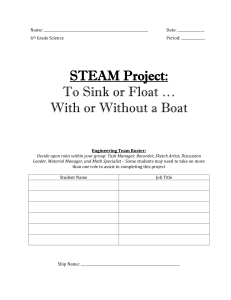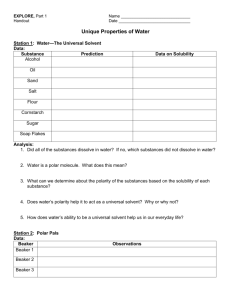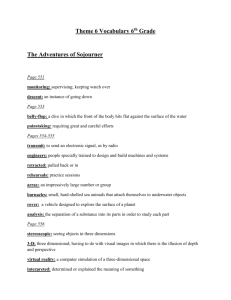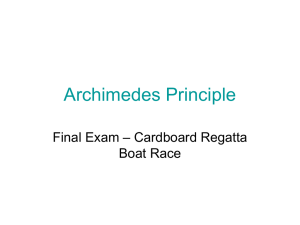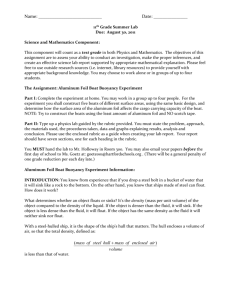Lab Archimedes` Principle
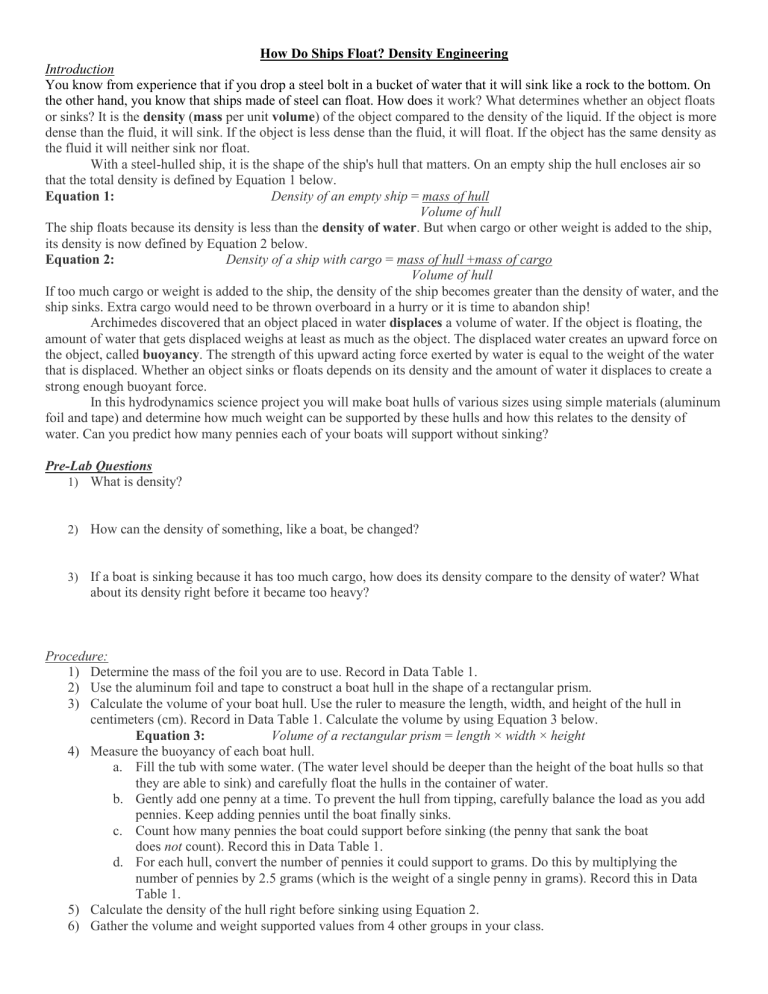
How Do Ships Float? Density Engineering
Introduction
You know from experience that if you drop a steel bolt in a bucket of water that it will sink like a rock to the bottom. On the other hand, you know that ships made of steel can float. How does it work? What determines whether an object floats or sinks? It is the density ( mass per unit volume ) of the object compared to the density of the liquid. If the object is more dense than the fluid, it will sink. If the object is less dense than the fluid, it will float. If the object has the same density as the fluid it will neither sink nor float.
With a steel-hulled ship, it is the shape of the ship's hull that matters. On an empty ship the hull encloses air so that the total density is defined by Equation 1 below.
Equation 1: Density of an empty ship = mass of hull
Volume of hull
The ship floats because its density is less than the density of water . But when cargo or other weight is added to the ship, its density is now defined by Equation 2 below.
Equation 2: Density of a ship with cargo = mass of hull + mass of cargo
Volume of hull
If too much cargo or weight is added to the ship, the density of the ship becomes greater than the density of water, and the ship sinks. Extra cargo would need to be thrown overboard in a hurry or it is time to abandon ship!
Archimedes discovered that an object placed in water displaces a volume of water. If the object is floating, the amount of water that gets displaced weighs at least as much as the object. The displaced water creates an upward force on the object, called buoyancy . The strength of this upward acting force exerted by water is equal to the weight of the water that is displaced. Whether an object sinks or floats depends on its density and the amount of water it displaces to create a strong enough buoyant force.
In this hydrodynamics science project you will make boat hulls of various sizes using simple materials (aluminum foil and tape) and determine how much weight can be supported by these hulls and how this relates to the density of water. Can you predict how many pennies each of your boats will support without sinking?
Pre-Lab Questions
1)
2)
What is density?
How can the density of something, like a boat, be changed?
3) If a boat is sinking because it has too much cargo, how does its density compare to the density of water? What about its density right before it became too heavy?
Procedure:
1) Determine the mass of the foil you are to use. Record in Data Table 1.
2) Use the aluminum foil and tape to construct a boat hull in the shape of a rectangular prism.
3) Calculate the volume of your boat hull. Use the ruler to measure the length, width, and height of the hull in centimeters (cm). Record in Data Table 1. Calculate the volume by using Equation 3 below.
Equation 3: Volume of a rectangular prism = length
× width
× height
4) Measure the buoyancy of each boat hull. a.
Fill the tub with some water. (The water level should be deeper than the height of the boat hulls so that they are able to sink) and carefully float the hulls in the container of water. b.
Gently add one penny at a time. To prevent the hull from tipping, carefully balance the load as you add pennies. Keep adding pennies until the boat finally sinks. c.
Count how many pennies the boat could support before sinking (the penny that sank the boat does not count). Record this in Data Table 1. d.
For each hull, convert the number of pennies it could support to grams. Do this by multiplying the number of pennies by 2.5 grams (which is the weight of a single penny in grams). Record this in Data
Table 1.
5) Calculate the density of the hull right before sinking using Equation 2.
6) Gather the volume and weight supported values from 4 other groups in your class.
Data:
Table 1
Mass of the foil Dimensions of the boat ( l x w x h )
Table 2
Group
1 (your group)
2
3
4
Volume (in cm 3 ) Number of pennies supported
Volume (in cm 3 )
Weight supported
(in grams)
Weight supported
Density before sinking (in g/cm 3
5
Data Analysis:
Make a line graph of buoyancy using the data in Data Table 2. To do this put the weight supported by the boat (in grams) on the y-axis and the boat hull volume (in cm³) on the x-axis. Include each boat on your graph.
)
Answer on a separate sheet of paper, using complete sentences for each answer:
1. What do your results tell you about the relationship between buoyancy (amount of weight a boat can support) and volume of the boat hull?
2. Different materials are useful for different boats. A boat can be made of steel, wood, or aluminum, but never cotton.
Describe the important properties a material must have in order to be a boat.
3. Unlike a ship, a submarine can control its buoyancy, thus allowing it to sink and surface when it wants to. To control its buoyancy, the submarine has tanks that can be alternately filled with water or air.
Using what you know about density and buoyancy from this activity, explain how you think a submarine works.


